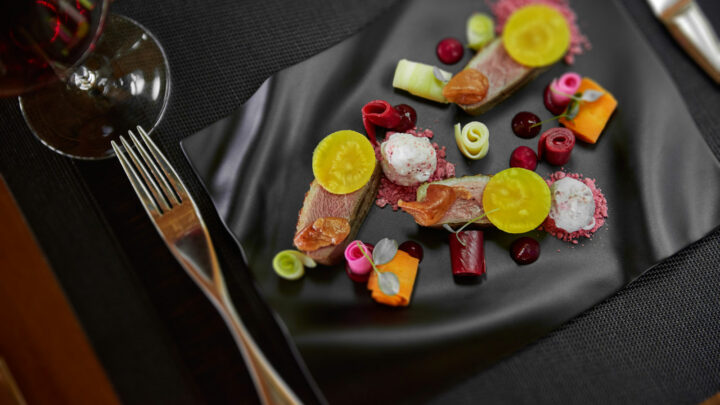
Halaveli Memories: A food journey at Jing
[vc_row][vc_column][vc_column_text]The path to Jing is lit up with lamps along its perimeter, the light pooling into the walkway from their square metal grills. Jing is Constance Halaveli’s fine-dining restaurant and it sits over a patch of water imbued with a vibrant blue with special lights; to attract fish, I’m told. The restaurant is all wood and glass at the entrance, the bar area, with comfortable rattan furniture dotting the interior. As we enter the restaurant proper, I notice its high wooden ceiling in the shape of an inverted dhoni; a recurring theme in the resort’s architecture, found also in its accommodation.
We are met by Jordi Vila, the young executive chef, and our guide Laila leads us down to the restaurant’s wine cellar, one of two at the resort. Its cool atmosphere is strictly maintained, but isn’t unpleasant. The cellar houses around a thousand bottles of red wine, and they’re nestled in compartments in a gently curved shelf in front of me.
We sit underneath a domed ceiling around a round table laid with a spotless white cloth. Vila takes his seat next to me. The multi-course tasting menu that he has prepared is about to be brought in dish by delectable dish.
We start off with a delicate appetiser of sorts, corn in a cone of rice paper wedged into a small twig. The cone is to be placed in the mouth in its entirety, and it leaves a pleasing, popcorn-like taste while the rice paper slowly dissolves.
Up next, lobster bisque in test tubes. “The lobsters have been cooked for several hours,” Jordi Vila informs. “Hence the robust taste,”. It’s kind of like an espresso with seafood instead of coffee, and it leaves a delicious aftertaste. We’re gently being ushered into the journey, with waypoints marking highlights of the night.
Over the meal Chef Jordi talks about his inspiration; he draws it from his travels, from his encounters with different flavour combinations in different parts of the world. They stimulate him and influence his cooking.
Take the tuna for instance. The fish is lightly marinated, drizzled with vinegar and olive oil, coupled with soy sauce and Yuzu caviars and served with an avocado salsa. This is the young chef’s idea of a marriage between Japan and Spain (Vila’s from Barcelona). It’s an amazing dish, the tuna is piquant with the salsa complimenting it perfectly. Creating a union that feels natural between these seemingly disparate ingredients is Jordi Vila’s magic.
He’s also playful with ingredients, with presentation. Take the salmon: lightly cooked and marinated, it’s presented in the curve of a green bottle that appears to have been sawn in half. Or the ‘stone potatoes’ that are nestled among dark stones, which makes it difficult to spot at first glance which is edible. The potatoes have been coated in squid ink. I take one and the skin crunches when I bite into it; it is distinctly potato flavoured but with a strange yet beguiling taste that, I assume, must be the ink.[/vc_column_text][vc_gallery interval=”10″ images=”10643,10644,10645″ img_size=”full”][vc_column_text]Chef Jordi may also present the same base ingredient differently. For instance, cold foie gras that’s served on a skewer and tastes like a bit like a strong, tart cheese, is followed again by foie gras; a continuation, in the chef’s words. In the second iteration, the liver appears with red chard draped over it along with rhubarb and crumbled ginger and aniseed. Where the first is cold, this is hot, where the first is tart and inert, this is sweet and spicy. Taken together, they’re like yin and yang, opposites that, instead of negating, complement each other.
There is connectedness to Jordi Vila’s offerings as well. The Wagyu beef main is paired with seaweed not just for the umami flavour. The beef comes from the south of Japan, where cows graze close to the sea; the seaweed and the beef are thus thematically related.
Or consider the duck. Accompanied by a strawberry coated with munitol sugar, beetroot, a dollop of raspberry and some chard, the dish has a red theme. It’s not only a looker but the duck, which has been marinated for over twelve hours, is tender and full flavoured, with beetroot and the fruits adding a touch of sweetness to the dish.
Desserts are equally impressive. The Granny Smith apple with blue cheese and mandarin reduction combines the citrus notes of apple with the tangy sweetness of mandarin and the distinctly sharp flavour of the cheese. The characteristically playful last dish, ‘Viaje A La Habana’, consists of a chocolate Cuban cigar and chocolate ‘coconut’ presented on a real, cold “iced plate”. It is a bit of fun at the end of a seriously intense session of degustation. The ‘coconut’ has to be broken by hitting it with a fork and it reveals the white insides, luscious and unmistakably coconutty. The cigar, served on an ashtray adds a bittersweet touch to the end of the affair.
I leave the restaurant in awe of the talent of Chef Jordi and his team. Not only their talent but the exactness with which everything was executed, the attention to detail, the sheer level of work and care that had gone into making each dish what it was. Constance’s tagline is “Be Inspired”, and I can think of no better embodiment of this than the team at Jing.[/vc_column_text][/vc_column][/vc_row]






